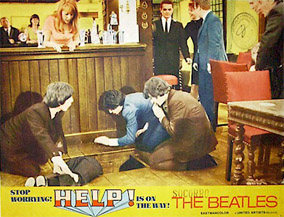|
|
Chapter Two: HelpBy Brett BeachApril 22, 2010
It would be an exercise in futility to attempt to chart the logistics of the screenplay as constructed by Marc Behm & Charles Wood but admiration must be given to any story that allows an on-screen moment for an escaped tiger who can only be soothed with a spirited humming of Beethoven’s Ode to Joy. Interspersed with The Beatles numbers are more than a few classical riffs and references such as this that help place the band in a larger context while almost foreshadowing the day their songs would be deemed classic rock. Having not seen A Hard Day’s Night yet (with its Oscar-nominated screenplay by Alun Owen) I can only hazard a guess that Help! comes off as more frenetic and vignette-driven than the former. A Hard Day’s Night would seem bound by its mockumentary approach and 36 hours in the life of time constraints while Help! suffers from no such restrictions. It strives for a sustained absurdity that heralds the impending arrival of Monty Python’s Flying Circus but is entirely too good-natured to crossover into that level of cut-throat take no prisoners satire and silliness. This everything-and-the-kitchen sink –approach certainly allows for any number of surprises as to where the action will turn to next but it also guarantees a certain raggedness and level of exhaustion, like a veddy British live-action take on a Looney Tunes theme. When the story simply forces itself to come to an end, to find a way to draw the curtain on the hijinks, it comes as somewhat of a relief. Still for its energy, its music, its dazzling splash of colors (particularly as rendered in the print used for the 2007 DVD transfer) and for its furthering of The Beatles as icons in their own time, I am happy to have Help! Now just imagine The Rolling Stones or Led Zeppelin having attempted something similar. Having a hard time doing so? Precisely. Next time: Because really, why SHOULD everyone have to die at the end of Hamlet?
|

|
|
|

|
Sunday, May 5, 2024
© 2024 Box Office Prophets, a division of One Of Us, Inc.


